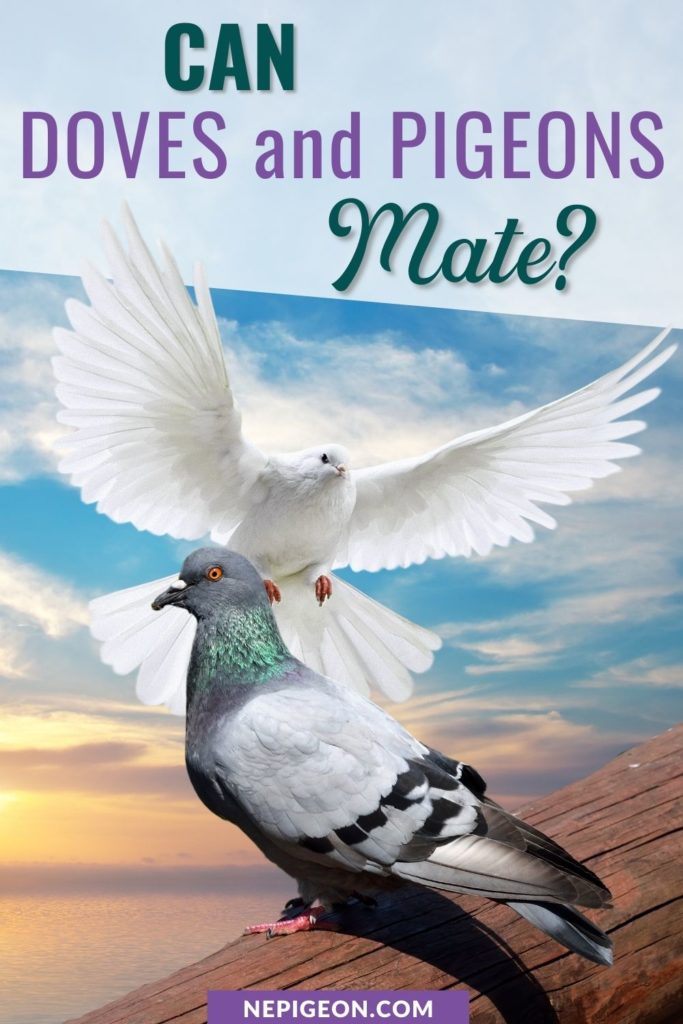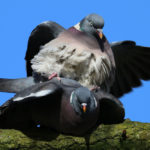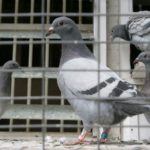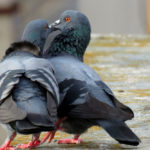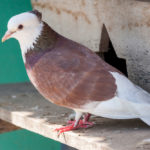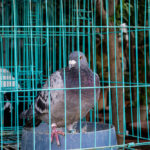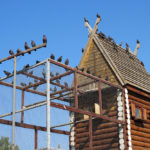Doves and pigeons can mate, although their offspring are often unhealthy. You would have to go all the way back to 1905 to find a verified report of wild doves mating with wild pigeons.
And the reason you can’t find a good answer to this question just by Googling it (until now) is that the scientific work to determine the best way to mate doves and pigeons was done in the 1930s and 1940s.
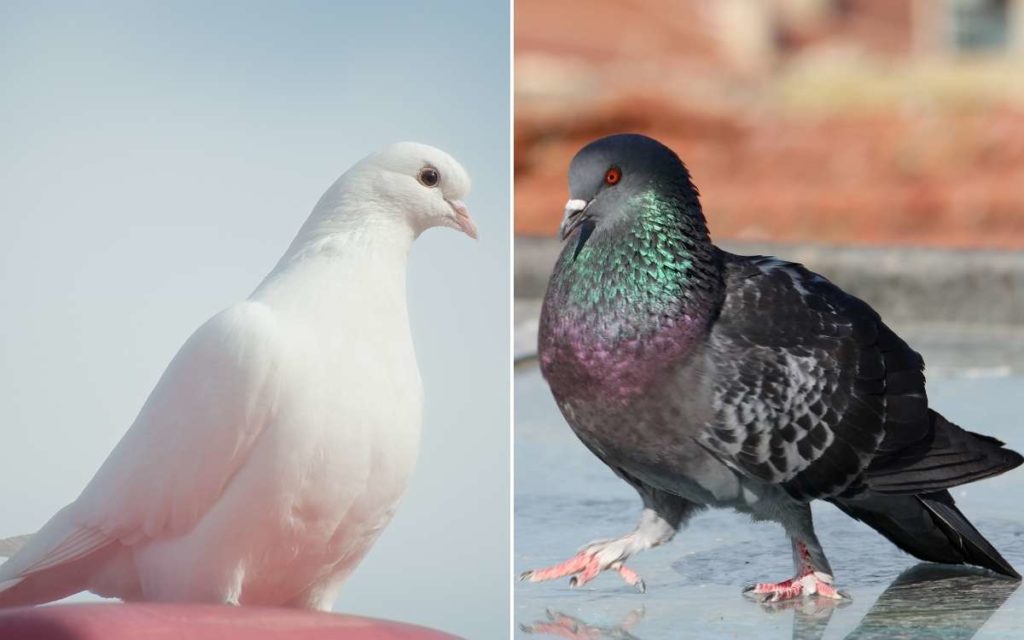
In this article, we will tell you everything you need to know about mating doves and pigeons and how to take care of their chicks.
Aren’t pigeons and doves the same?
The terms dove and pigeon are often used interchangeably as if they were the same bird. Actually, they are two different but closely related species of birds in the same family, Columbidae.
Doves were closely related to the lamented passenger pigeons, which were hunted to extinction in the nineteenth century. There are varieties of doves, such as Barbary doves, that look a lot like pigeons.
But there are also a number of differences between doves and pigeons that make mating unusual.
- Doves are considerably smaller than pigeons. It is relatively easy for a female dove to mate with a male pigeon, but differences in size make it difficult for a male dove to mate with a female pigeon.
- Pigeons are, as described by scientists 70 years ago, “boisterous” in their lovemaking. Doves show a “mild disposition” when they are mating. Only pure-bred pigeons of unusually calm breeds, such as Owls, Tumblers, and Tippers, successfully mated with doves in the experiments done in the 1930s and 1940s. In our time, an unusually calm breed like the King pigeon would be the choice to make mating with doves more likely.
- Both doves and pigeons prefer to mate with their own species. They are only likely to breed when they are confined together in an aviary with no other potential mates.
Both doves and pigeons can be bred by artificial insemination. However, getting doves and pigeons to mate is only part of the problem.
There Is Only One Way to Cross Doves and Pigeons that Results in Fertile Eggs
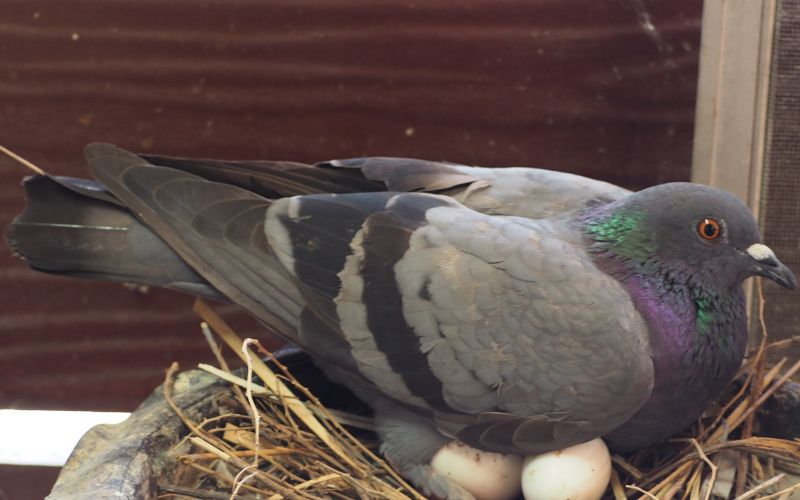
Two scientists in the Genetics Department at the University of Wisconsin, L. J. Cole and W. F. Hollander crossed hundreds of doves with hundreds of pigeons in the 1940s. They found dramatic differences in the fertility of eggs from crossing doves and pigeons that depended on whether the female was a dove or a pigeon.
Eight matings of male pigeons with female doves resulted in 104 eggs. All 104 eggs were infertile. Seven matings of female pigeons with male doves resulted in 147 eggs, 138 of them fertile.
Twelve matings of female pigeons with male doves resulted in 304 eggs, all of them infertile. The scientists tried mating female pigeons with male doves a second time and the females laid 63 eggs, 6 of them fertile.
It is possible that the differences in size between the two species of birds make it impossible for the male’s sperm to travel down the female’s cloaca except when a male dove is mated with a female pigeon. In any case, it is the eggs laid by a pigeon that is mated with a dove that is most likely to hatch.
Other crossings resulted in hybrid embryos that died in the “blood ring” stage, just as the blood vessels were about to form.
The scientists overlooked another reason mating female pigeons with male doves gets better results.
Pigeon eggs are about twice as large as dove eggs.
The developing hybrid has many more resources inside a pigeon egg than inside a dove egg. The hybrid chicks that hatch from pigeon eggs are almost twice as large as the hybrid chicks that hatch from dove eggs.
But researchers who tried different breeds of pigeons got better results.
Two scientists working at both the University of Texas at Austin and the University of Wisconsin at Madison, Theophilius Painter, and Leon J. Cole, reported in 1943 that just 3 percent of the hybrids they obtained by crossing a female dove with a male pigeon were females.
The other 97 percent were males. The scientists found that there was some hormone missing in the egg that female chicks needed for continuing development.
Painter and Cole’s female hybrids were delicate, small, and not interested in sexual behavior. The males, on the other hand, were virile, aggressive, and very interested in sexual behavior. However, most of them were sterile.
If You Successfully Cross a Dove and a Pigeon, What Do You Get?
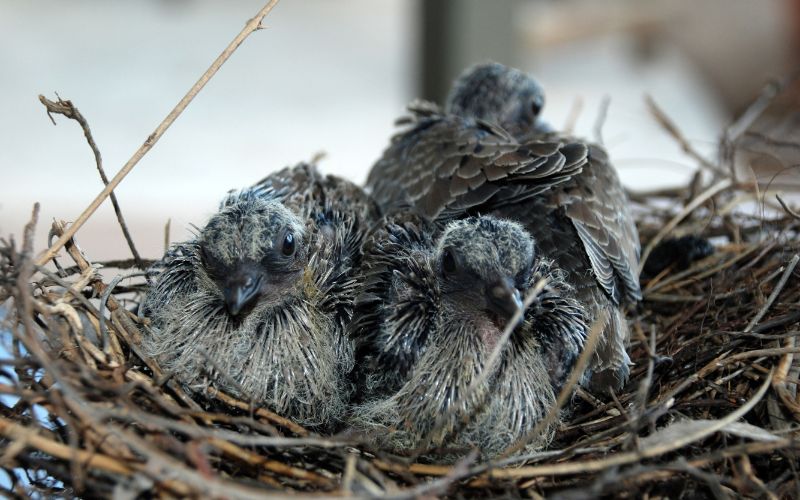
Dr. Cole and Dr. Hollander raised hundreds of hybrids from the mating of male doves and female pigeons to maturity. They even tried mating the hybrids with each other and with normal doves and pigeons. But the hybrids did not display characteristics that bird breeders expect from either bird.
From observing 225 hybrid birds, almost all of them male, Cole and Hollander observed differences in:
Incubation time: Pigeon eggs usually take about 17 days to hatch. Dove eggs usually take about 14 days to hatch, The hybrid eggs hatched out in an average of 18 days. Another experiment found hybrids hatched after an average of 19 days if they were laid by pigeons.
Neck feathers. The researchers’ pigeons had iridescent neck feathers, acting something like a prism to reflect all the colors of the sun. They did not have a “collar.” Their doves had a black collar with a white edge, but their neck feathers were not iridescent. The hybrids had broad, scaly neck feathers with iridescent tips.
Greeting laugh. Cole and Hollander’s pigeons did not greet them with a “laugh.” Their doves, however, would greet them with five or six notes. The hybrids offered them half of a greeting, with just two or three notes.
Courtship coo. When pigeons are in the mood for love, Cole and Hollander noted, they made a rolling, staccato courtship coo. Their doves chirped a rolling melody to try to attract a mate. The female hybrids did not make any effort to attract a mate, but the males made a hoarse, undulating yodel.
Tendency to fight other birds. Cole and Hollander noted that their pigeons were pugnacious, always ready to fight other birds. Their doves, on the other hand, were mostly peaceful. The hybrids, however, were usually ready to fight with other birds over food, water, and desirable locations in their cages.
Nostril cere. The cere is the bulb-like, fleshy area above a bird’s beak and below its eyes. It looks as if it connects a bird’s beak to its face. Cole and Hollander’s pigeons had chalky ceres. Their doves had ceres that did not have a chalky appearance. The ceres of the hybrids were in between.
Body weight. Cole and Hollander’s male pigeons weighed an average of 397 grams. Their female pigeons weighed an average of 322 grams. Their male doves weighed an average of 190 grams. Their female doves weighed an average of 158 grams. Their hybrids, nearly all of which were male, averaged 225 grams.
Toe size. The size of the middle toe makes a big difference in the ability to run across the ground and to hold on to a perch. Cole and Hollander’s male pigeons had an average middle toe size of 30 mm, females 28 mm. Their male doves had an average middle toe size of 25 mm, females 23 mm. The average middle toe size of the hybrids, nearly all of them male, was 25 mm.
Feather length. Pigeons have tail feathers that are only about 70 percent as long as their wing feathers. Doves have tail feathers that are about 90 percent as long as their wing feathers. Courtney and Hollander expected the hybrids to have tail feathers about 80 percent as long as their wing feathers, but they were actually about 84 percent. Their plumage was closer to dove than to pigeon.
Reproductive capacity. A few of the female hybrids showed interest in sexual activity, but their ovaries never matured so that they could lay eggs. The male hybrids were mostly very virile and very interested in sex, although they produced very few normal sperm.
Longevity. The few female hybrids that survived lived only a few months, except for one that lived to the age of 16 months. Contrastingly, many of the male hybrids lived five to seven years. A few lived to be 12 years old, which is very old for either a dove or a pigeon.
Cole and Hollander also tried to mate hybrids back to doves to create a bird that is 3/4 dove and 1/4 pigeon. About 2 percent of the eggs from these crosses hatched. Because of defects in sperm production, they actually got “triploids,” birds that were 2/3 dove and 1/3 pigeon.
None of the crosses between hybrids and pigeons yielded fertile eggs.
Are There Any Advantages to Crossing Doves and Pigeons?
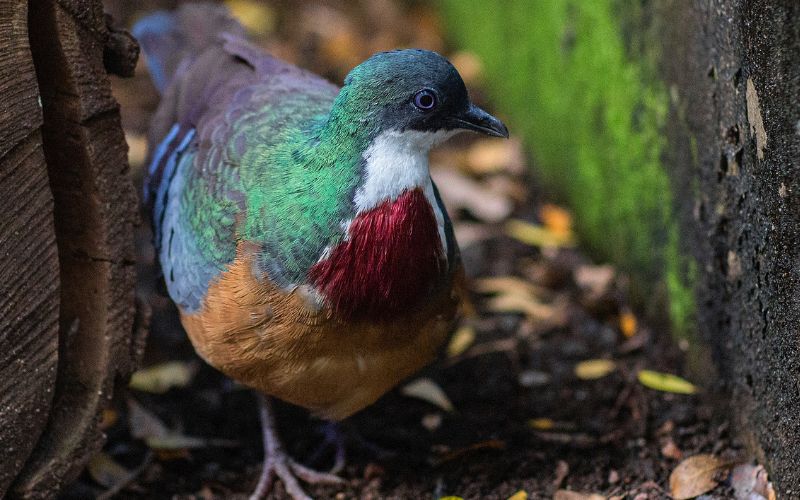
Crosses of doves and pigeons create hybrids with at least one interesting feature:
Over 20 mutations of feather color have appeared in hybrids of doves and pigeons that do not appear in their parental lines.
Hybrids can have feathers of bronze, ash-red, almond, yellow, smokey black, and white. Some had feathers on their toes. One had silky feathers, and several had whorls on their crops. They cannot, unfortunately, pass these genes on to another generation.
People Also Ask About Mating Doves and Pigeons
Are pigeons and doves the same?
Pigeons and doves are in the same family of birds, but they are not identical species. They differ in size, feather color, preferred habitat, and behavior.
Can dove species interbreed?
Successful breeding of two different kinds of birds in the Dove Family, such as mating a dove with a pigeon, is only possible if the larger bird is the mother. Larger birds lay larger eggs, which provide more nutrition to the developing chick.
Will pigeons cross breed?
Pigeons will mate with their cage mates. However, only female pigeons can mate with smaller birds and produce viable eggs.
Are pigeons and doves cousins?
Pigeons and doves are different species, but they are both placed in the family Columbidae. Scientists note that there are extreme differences even within the same species of pigeons, so it is possible to find breeds of pigeons that are very similar to doves.
